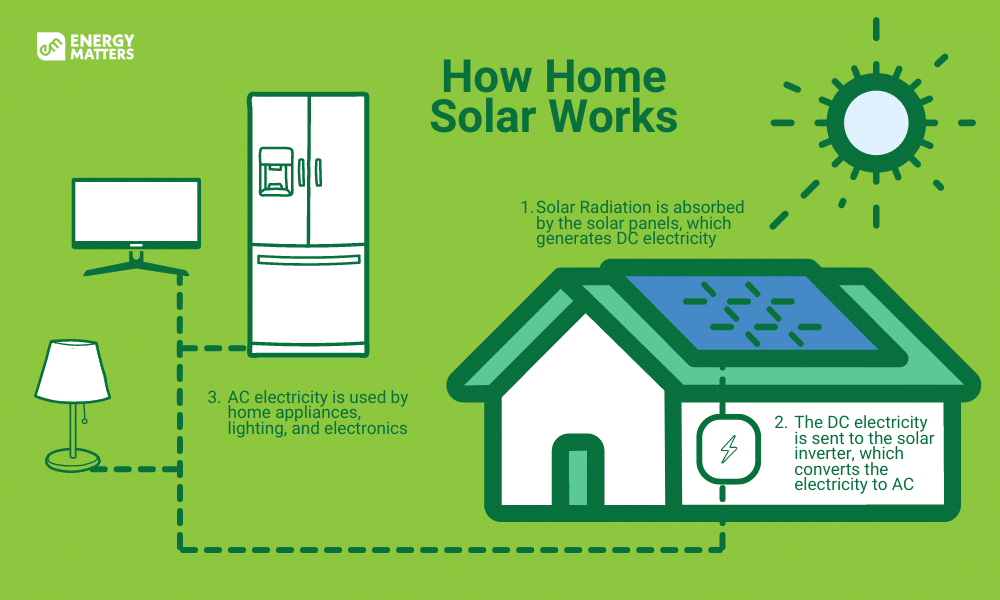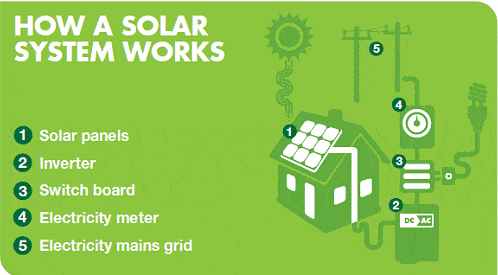Solar energy has become increasingly popular for homes and businesses in Australia, offering a clean and sustainable alternative to traditional electricity sources. But how exactly does solar power work using a solar energy diagram?
Is solar energy suitable for your home and business? Solar energy has numerous advantages that are worth investigating. Investing in solar will minimise your electrical bills and reduce your company’s and household’s carbon footprint.
Contact us today for up to 3 FREE quotations from solar firms we’ve pre-qualified and vetted for their track record of delivering Australia’s best business and household solar systems.
Understanding the basics: How solar panels work
At the heart of solar power lies the photovoltaic (PV) cell. These amazing little devices are made from semiconductor materials like silicon. When sunlight strikes a PV cell, the energy from the photons (light packets) disrupts its electrons, causing them to flow and generate electricity. This electricity is in the form of direct current (DC).
Here’s a breakdown of the solar power generation process:
- Sunlight absorption: Sunlight bathes the solar panels, and the PV cells within them absorb the photons.
- Electron flow: The absorbed photons energise the silicon electrons, causing them to jump to a higher energy level. This creates a flow of electrons, resulting in direct current (DC) electricity.
- Direct Current (DC) to Alternating Current (AC): Household appliances and the national grid typically use alternating current (AC) electricity. An inverter, a crucial component in the solar power system, converts the DC electricity generated by the panels into usable AC electricity.

Explanation of the solar energy diagram
Now, let’s visualise the process with a diagram of solar energy specific to the Australian context:
- Sunlight strikes the solar panels mounted on your rooftop, ideally facing north in the southern hemisphere to maximise sun exposure.
- The PV cells within the panels convert this sunlight into DC electricity.
- The DC electricity travels through cables to the inverter, the system’s workhorse.
- The inverter converts the DC electricity into usable AC electricity, which powers your appliances.
- The converted AC electricity is then directed to your home’s meter, which monitors your electricity usage.
- Now, there are two main scenarios:
- If your solar system generates enough electricity to power your home during the day, you’ll utilise this clean, solar-generated power, reducing your reliance on the grid.
- If your solar system produces more electricity than your home needs (often during peak sunshine hours), this surplus can be exported back to the grid through a net metering system. You may receive a feed-in tariff from your electricity provider for this exported power in Australia.
A typical solar power system consists of the following components:
1. Solar panels
These panels, the system’s workhorses, are made up of photovoltaic (PV) cells. These cells are constructed from silicon, a material energised by sunlight. When sunlight strikes the PV cells, it creates an electric field, generating direct current (DC) electricity. Check out our page for the Best Solar Panels in Australia.
2. Solar inverter
Our homes don’t directly use the DC electricity the panels produce. Here’s where the inverter comes in. This crucial component transforms the DC electricity from the panels into alternating current (AC) electricity, which is used to power our appliances and lights. Check out our page for the Best Solar Inverters in Australia.
3. Monitoring system (optional)
Many solar power systems include a real-time monitoring system that allows you to track your energy production and consumption. This data can be accessed through a smartphone app or online portal, providing valuable insights into your solar energy usage.
4. Metering system
This system measures the electricity your solar panels generate and the amount you consume from the grid. In some cases, it can also track the excess electricity you feed into the grid.
5. Connection to the grid
Solar power systems can be grid-connected or off-grid. Grid-connected systems are the most common in Australia. They allow you to export any excess electricity your panels generate back to the grid, often receiving a credit on your electricity bill. On the other hand, off-grid systems are completely independent of the electricity grid and require battery storage to power your home during periods without sunlight.
Read more about:
Ready to upgrade your solar panels and take your energy savings to the next level? Embrace the energy efficiency revolution by upgrading your solar panels, battery or solar inverters with Energy Matters.
With our 3 free solar quotes, you can compare plans from pre-qualified and vetted installers in your area and find the perfect solution for your home and business. Harness the sun’s power and save money on electricity bills while reducing environmental impact. Let Energy Matters guide you towards a brighter, more sustainable future.
Here's a simplified breakdown of the process depicted in the solar panel connection diagram:
- Sunlight hits the solar panels. The PV cells in the panels convert sunlight into DC electricity.
- The DC electricity travels through cables to the inverter.
- The inverter converts the DC electricity into usable AC electricity.
- The AC electricity powers your home appliances and lights.
- Any excess AC electricity can be exported back to the grid (grid-connected systems only).

Factors affecting solar power
While Australia enjoys abundant sunshine, several factors influence the amount of electricity your solar system generates:
- Sunlight hours: As expected, locations with more sunshine hours will see higher electricity production. Northern parts of Australia generally receive more sunlight compared to southern regions.
- Panel orientation and tilt: For optimal performance, solar panels should face north and be tilted at an angle that matches your latitude. This ensures they capture the most sunlight throughout the year.
- Shading: Trees, buildings, or any object casting shadows on your panels can significantly reduce electricity generation.
- Panel efficiency: Different solar panel types have varying efficiencies in converting sunlight into electricity. Higher efficiency panels will generate more power for the same size.
- Temperature: Extremely hot temperatures can slightly decrease solar panel efficiency.
Benefits of solar power
Australia’s abundant sunshine makes solar power a highly attractive option for homeowners. Here are some key benefits:
- Increased property value: Homes with solar panels often command a higher market value due to the cost savings and environmental benefits.
- Government incentives: The Australian government offers subsidies, such as rebates and feed-in tariffs, to encourage the adoption of solar power.
- Environmentally friendly: Solar energy is a clean and renewable resource that helps to reduce greenhouse gas emissions and combat climate change.
- Reduced electricity bills: Generating your clean energy can significantly reduce your reliance on the grid, leading to lower electricity bills.
Are you looking to save money on your electricity bills and reduce your carbon footprint? Energy Matters has been a leader in the renewable energy industry since 2005 and has helped over 40,000 Australian households in their journey to energy independence.
With Energy Matters, you can be sure you’re getting the best possible deal on solar energy. We only work with reputable solar firms with a proven track record of delivering high-quality solar systems.
The Australian advantage: Government incentives and feed-in tariffs
The Australian government actively promotes solar power adoption through various incentives. These include:
- Solar rebates: Financial rebates are offered to help offset the upfront cost of installing a solar power system. These rebates vary depending on your location and system size.
- Instant asset write-off: Businesses can claim the entire cost of a new or upgraded solar system as a tax deduction in the year it’s installed.
- Feed-in Tariffs (FiTs): Many electricity retailers in Australia offer feed-in tariffs, which means you can earn money for any excess solar energy you export back to the grid.
Read more about:
- Home Solar Rebates, Incentives & Subsidies In Australia
- Solar power incentives, loans & rebates for small business
- Solar Battery System Rebates, Subsidies, & Incentives
- Australian Solar Feed in Tariffs Information
- Solar Feed-in Tariff Comparison: Best Tariffs by State and Territory
- Renewable Energy Certificates (RECs) information
- Large-Scale Generation Certificates (LGCs)
These incentives and Australia’s abundant sunshine make solar power a highly attractive and cost-effective option for homeowners and businesses.
Ready to go solar? Get an instant assessment
To find out how much a solar system with storage or even an EV charger will cost, try our easy-to-use solar power and battery storage calculator! It will generate performance data and possible cost savings.
We can forward your information to 3 trusted local installers in your area to obtain free, no-obligation solar quotes.
Find out how much you can expect to pay for solar
Ready to find out more? Get FREE quotes for solar, batteries + more
*Prices quoted are to be used as a guide only and do not factor in state and other rebates and incentives. Includes STC discount.







































